Richard Serra : Six Large Drawings
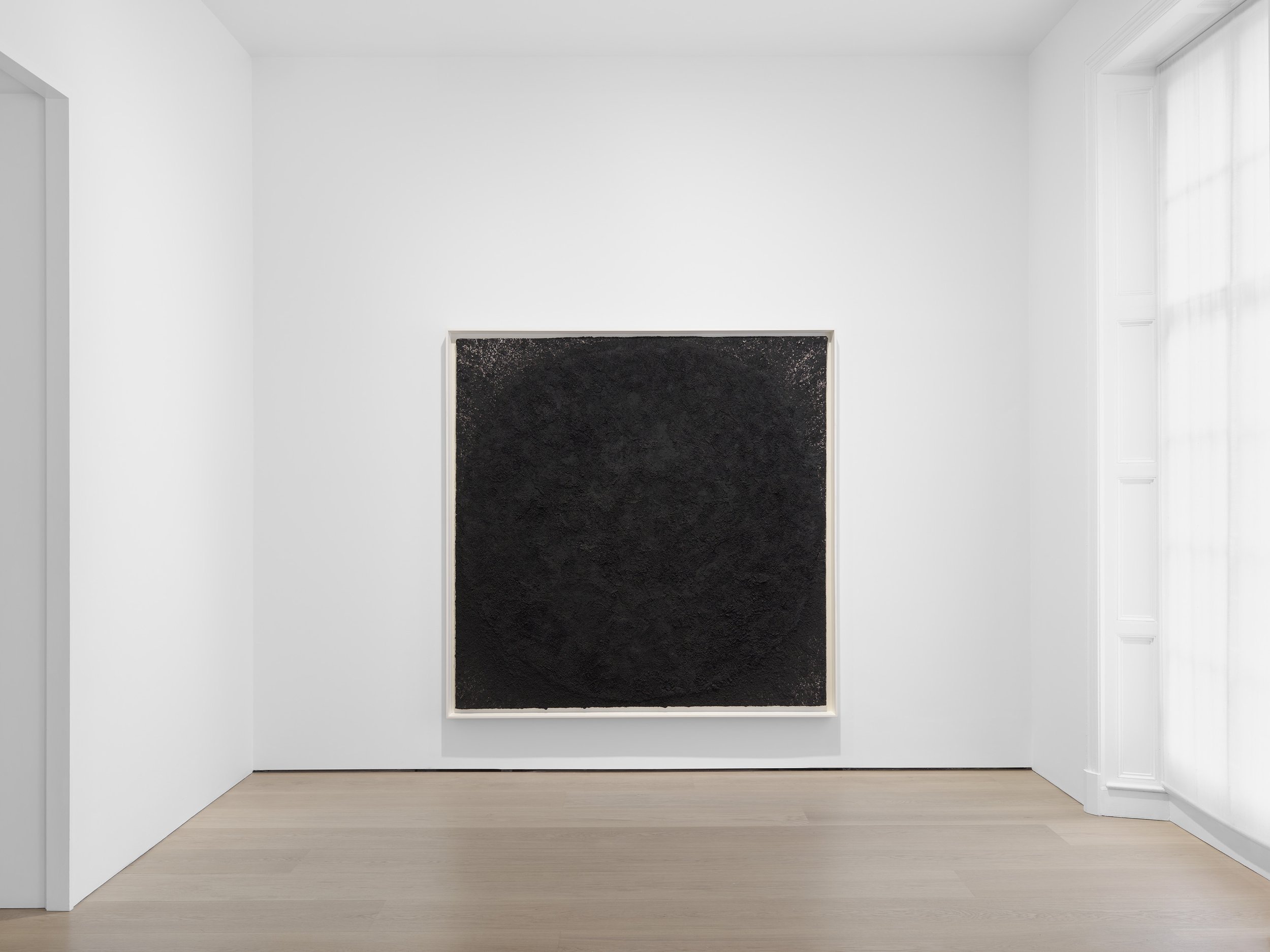
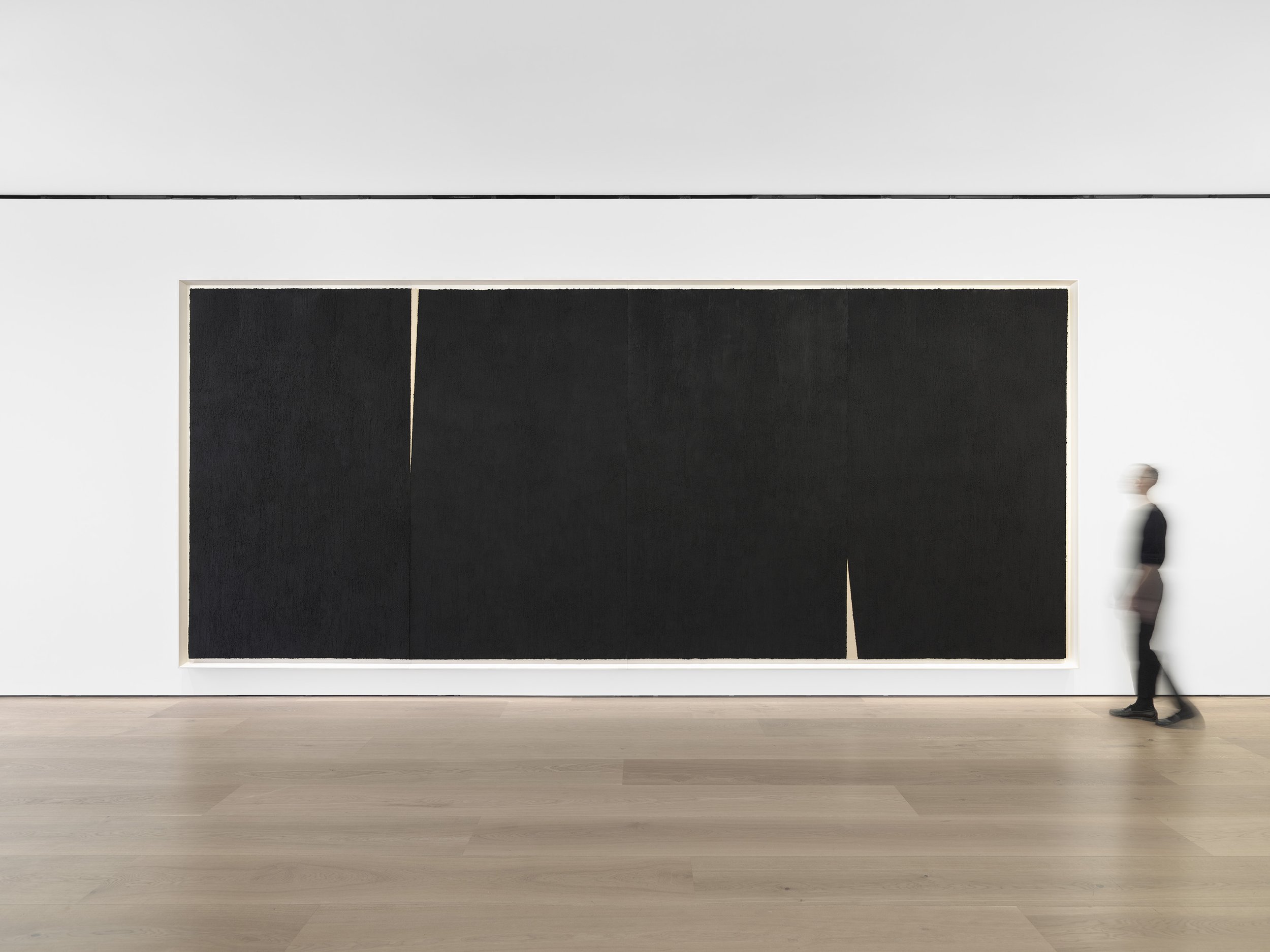
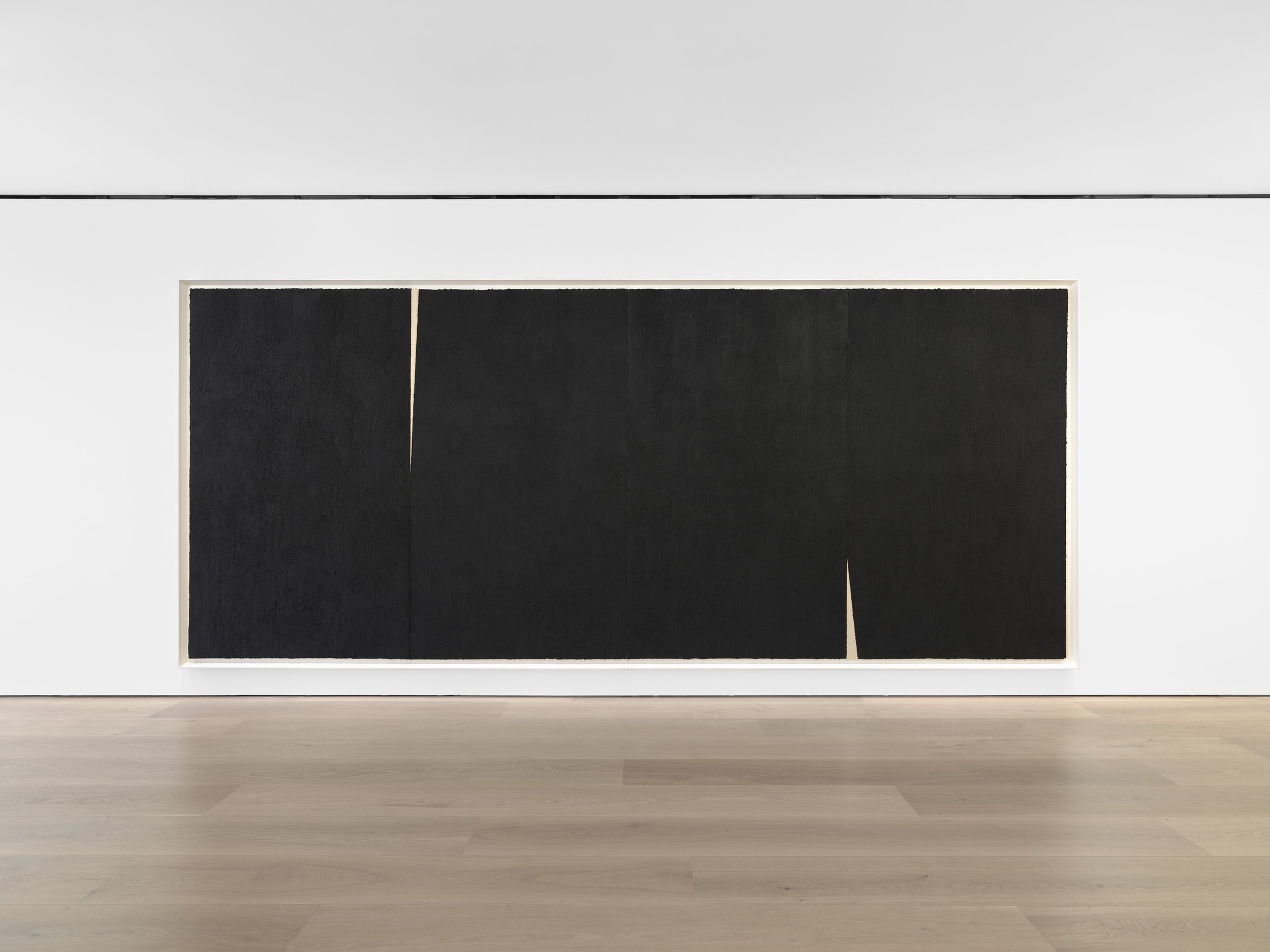
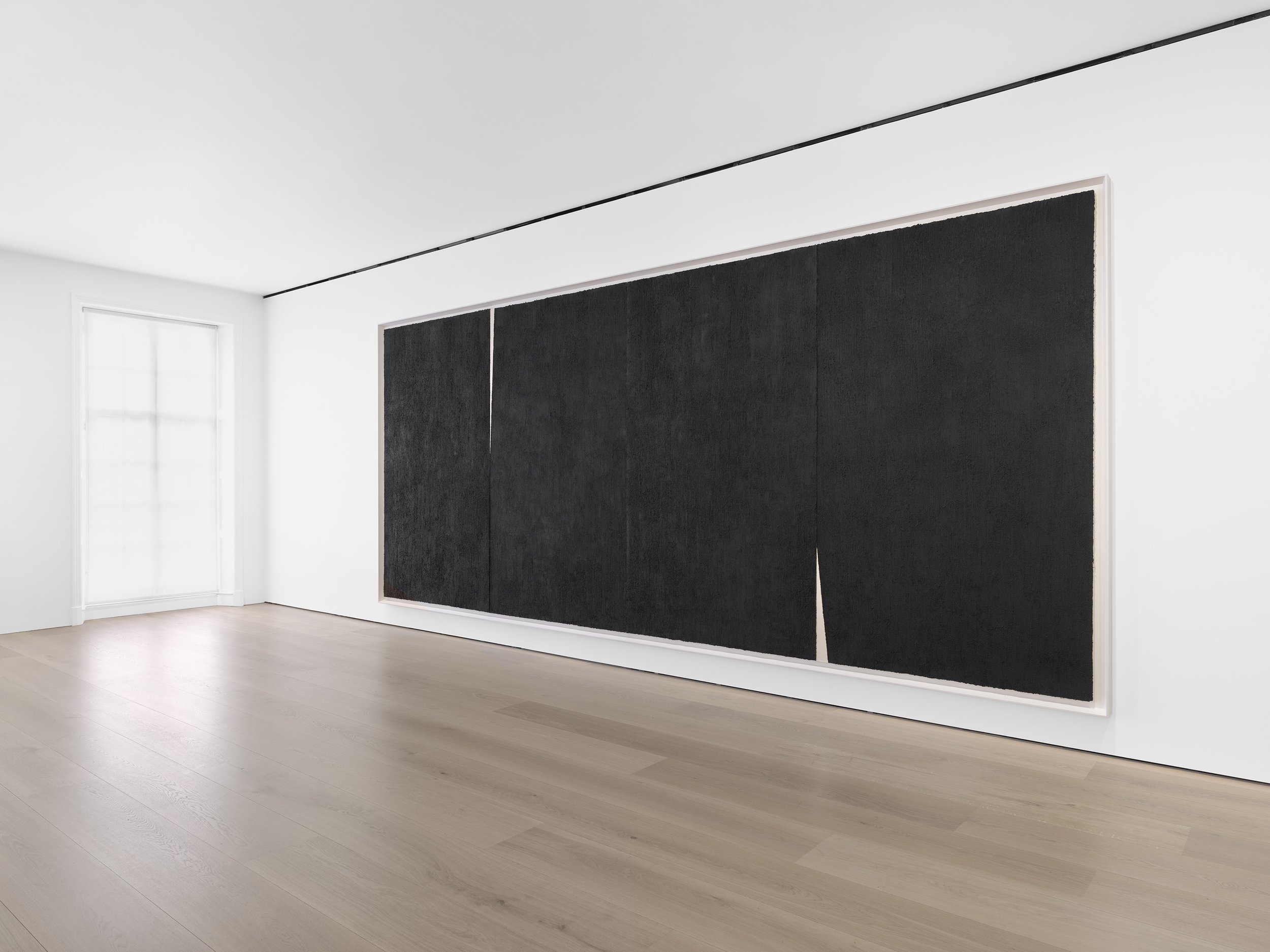
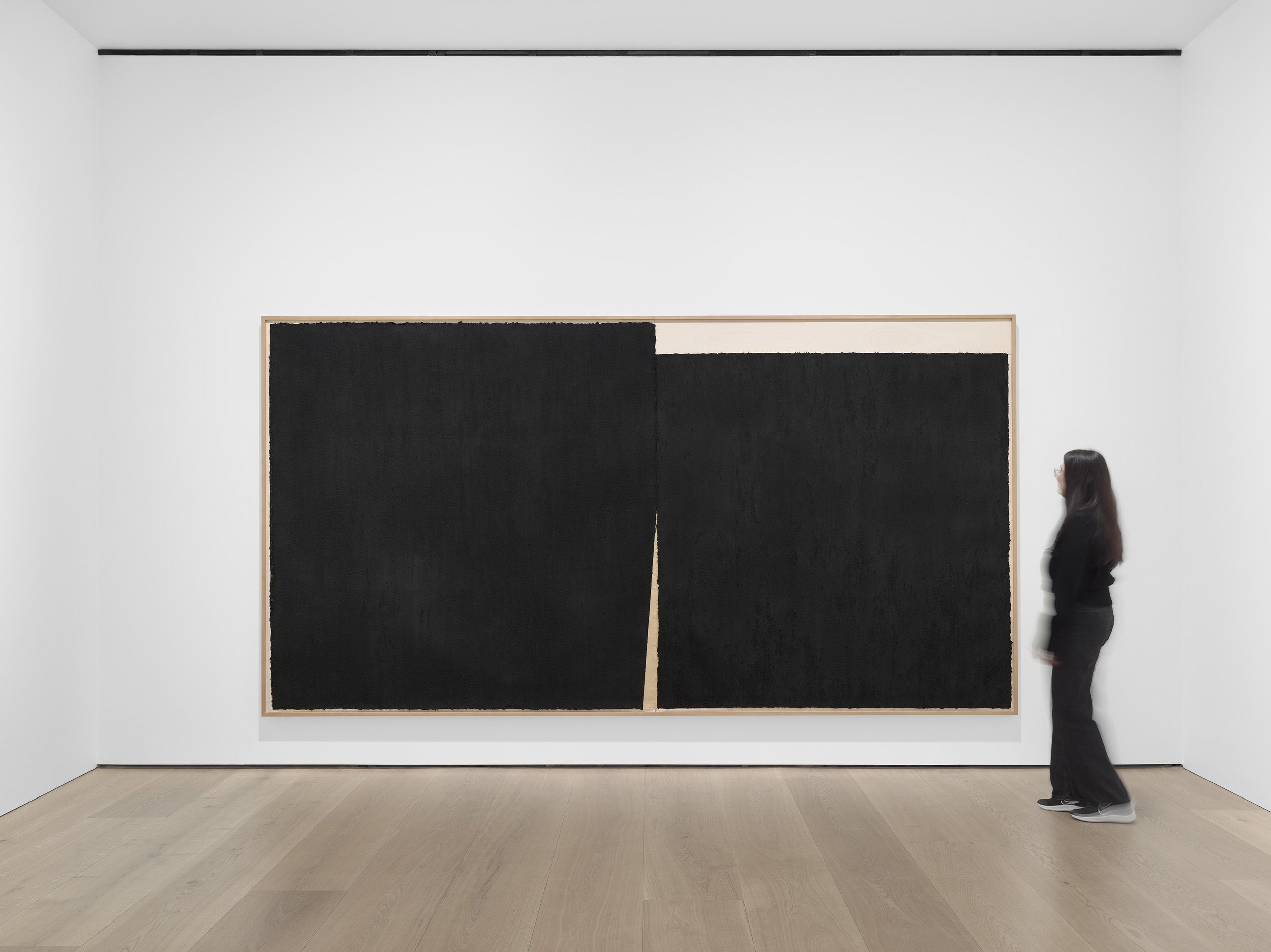
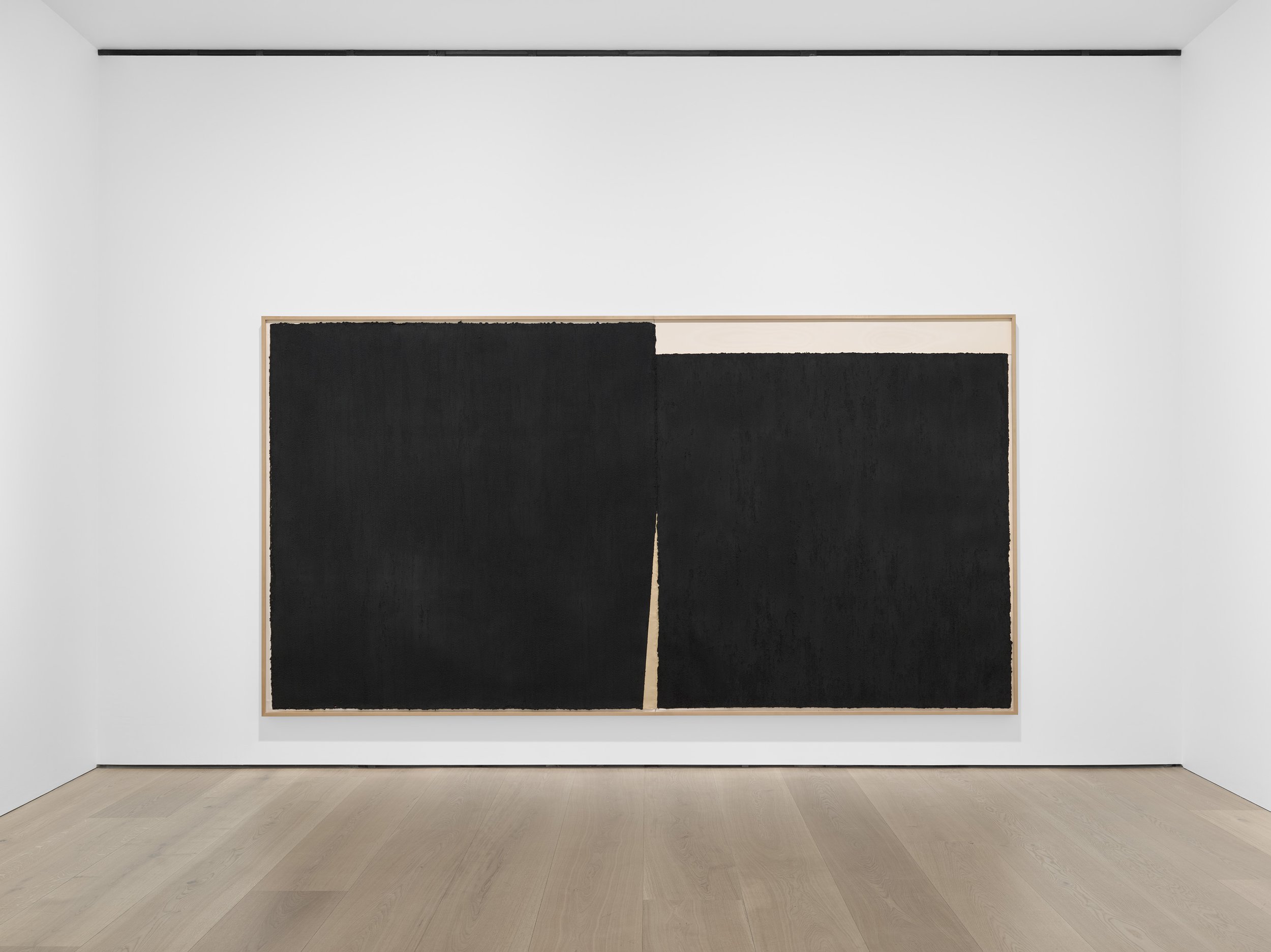
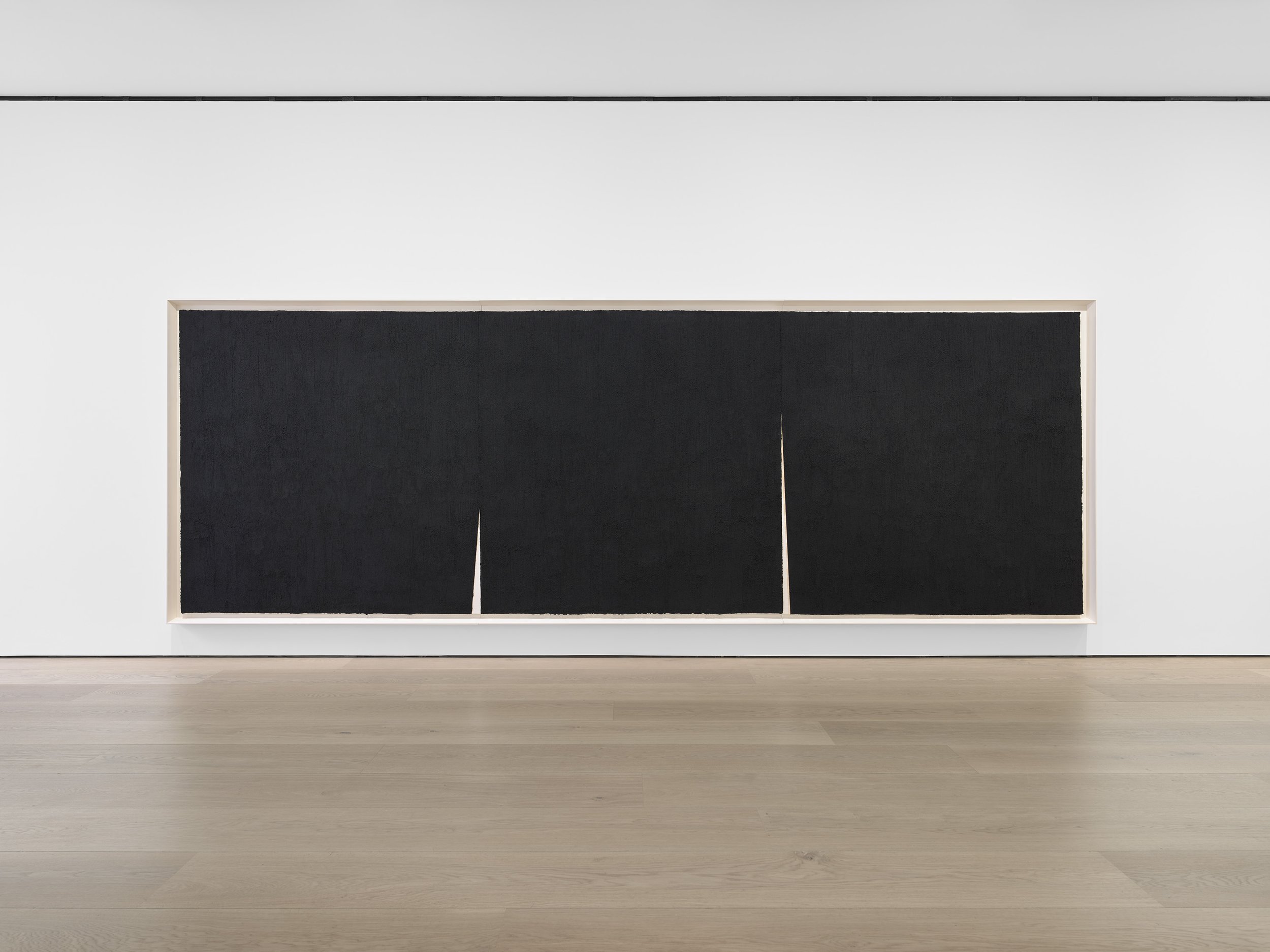
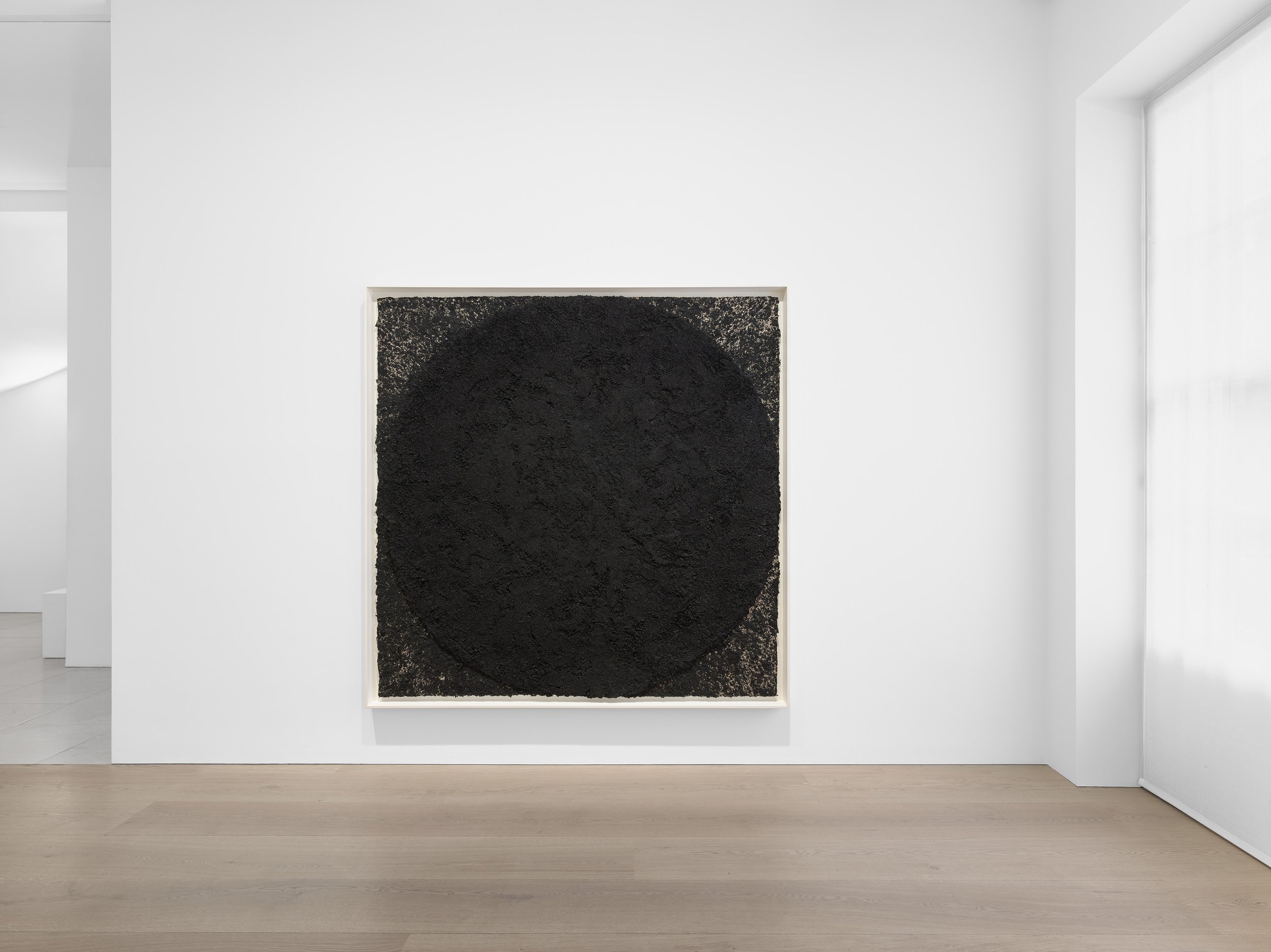
Installation Views: Richard Serra, Six Large Drawings, David Zwirner, London © Richard Serra Courtesy the artist and David Zwirner
Black is a property, not a quality. In terms of weight, black is heavier, creates a larger volume, holds itself in a more compressed field. It is comparable to forging. Since black is the densest color material, it absorbs and dissipates light to a maximum and thereby changes the artificial as well as the natural light in a given room. A black shape can hold its space and place in relation to a larger volume and alter the mass of that volume readily. 1 –Richard Serra
The exhibition of six significant drawings by American artist Richard Serra (1938–2024) are on view at the gallery’s 24 Grafton Street location in London.
Known for his large-scale, site-specific sculptures, Serra consistently produced drawings throughout his career. Beginning in 1971, the artist employed black paintstick (compressed oil paint, wax, and pigment) to create these works. Six Large Drawings is the last exhibition conceived by the artist during his lifetime. Reflecting a considered installation across both floors of the gallery, the presentation includes two of Serra’s large-scale diptychs from the early 1990s, two works from his series of Greenpoint Rounds (begun in 2009), and two multipanel Rift drawings (begun in 2011).
Richard Serra Triple Rift #2, 2018 Paintstick on four sheets of handmade Japanese paper © Richard Serra/Artists Rights Society (ARS), New York/ (DACS), London Courtesy the artist and David Zwirner
As Serra noted about the diptychs: ‘They are masses in relation to each other. They are not about composition or figure ground. They emphasize the comparison of different weights in juxtaposition.’ 2 He has also noted: ‘The construction of these large horizontal drawings refers to something I observed in Machu Picchu in Peru when I went there in 1974. The builders of Machu Picchu cut stones on the site and fit irregular shapes together; oftentimes, the edges only touch on one facet, and then there’s a void between them. It’s not that I went back to look at the notebook notations that I made in Cuzco when I started these drawings, but I’m sure it’s something that seeped into my memory. It is not that these horizontal constructions represent something I’d seen, but it means that there’s something in the reservoir of my understanding of how forms came together that I applied.’ 3
Since 1996, Serra revisited the circular format of ‘rounds’ in various iterations over the course of his career. On view are two works from the artist’s 2009 series of Greenpoint Rounds, which measure approximately eighty inches square. As he noted: ‘What happens in the [earlier Rounds] is that splatters, which are results of the process of making, start to animate the field. I've been working on a new series of large Rounds now since July [2009], trying to see if I could find a way to obliterate the shape even more, so that you are immediately drawn into the field of the drawing without focusing on the shape. What I tried to achieve with the Rounds was to make the mass flood the paper. I am trying to obliterate the shape to the degree that what you're looking at is a black field in which a tremendous amount of matter is pulverized into the paper.’ 4
Installation Views: Richard Serra, Six Large Drawings, David Zwirner, London © Richard Serra Courtesy the artist and David Zwirner
As Neil Cox has written of the Rifts, ‘Serra continues to work as a draftsman on a large scale. These polyptychs, drawn with prepared bricks of noxious black paintstick, made on huge sheets of handmade Japanese paper, were first shown in 2011. They are articulated by “rifts,” very thin vertical triangles where the paper is left blank, intersections that mark out the point of division of the constituent sheets.… The Rift drawings are formidable presences; they are typically at least 8 feet (2.5 metres) high, so giant in comparison to the standing spectator, and between 16 and 20 feet (5 and 6 metres) across, so capable of dominating the visual field.’ 5
Richard Serra was born in San Francisco and lived and worked in New York, the North Fork of Long Island, and Nova Scotia. His first significant solo exhibition was held at the Leo Castelli Warehouse, New York, in 1969. His first solo museum exhibition took place at the Pasadena Art Museum in 1970. Serra subsequently participated in numerous international exhibitions, including Documenta (1972, 1977, 1982, and 1987) in Kassel, Germany; the 1980, 1984, 2001, and 2013 editions of the Venice Biennale; and the Whitney Museum of American Art’s Annual and Biennial exhibitions of 1968, 1970, 1973, 1977, 1979, 1981, 1995, and 2006.
Richard Serra Double Rift #6, 2013 Paintstick on three sheets of handmade Japanese paper © Richard Serra/Artists Rights Society (ARS), New York/ (DACS), London Courtesy the artist and David Zwirner
Solo exhibitions of Serra’s work have been held at numerous public institutions worldwide, including, among others, the Museum Boijmans Van Beuningen, Rotterdam, the Netherlands, 1980; Musée National d’Art Moderne, Paris, 1984; Museum Haus Lange, Krefeld, Germany, 1985; The Museum of Modern Art, New York, 1986; Westfälisches Landesmuseum für Kunst und Kulturgeschichte, Münster, Germany, 1987; Städtische Galerie im Lenbachhaus, Munich, 1987; Stedelijk Van Abbemuseum, Eindhoven, the Netherlands, 1988; Kunsthaus Zürich, 1990; CAPC Musée d’Art Contemporain, Bordeaux, France, 1990; Museo Nacional Centro de Arte Reina Sofía, Madrid, 1992; Kunstsammlung Nordrhein-Westfalen, Düsseldorf, 1992; Dia Center for the Arts, New York, 1997; Centro de Arte Hélio Oiticica, Rio de Janeiro, 1997–1998; Trajan’s Market, Rome, 2000; Pulitzer Foundation for the Arts, St. Louis, 2003; and Museo Archeologico Nazionale di Napoli, Naples, 2004. In 2005, The Matter of Time, a series of eight large-scale works by Serra from 1994 to 2005, was installed permanently at the Guggenheim Museum Bilbao, and in 2007, The Museum of Modern Art, New York, presented the retrospective Richard Serra Sculpture: Forty Years. Promenade, a major site-specific installation, was shown at the Grand Palais, Paris, for MONUMENTA 2008. In 2011, the artist’s large-scale, site-specific sculpture 7 was permanently installed opposite the Museum of Islamic Art in Doha, Qatar. In 2014, the Qatar Museum Authority presented a two-venue retrospective survey of Serra’s work at the QMA Gallery and the Al Riwaq exhibition space, Doha, and East-West/West-East (2014) was permanently installed in the Brouq Nature Reserve in the Zekreet Desert, Qatar. In June 2020, a new major sculpture by Serra was installed on the West Quad of Kenyon College, in Gambier, Ohio. In 2022, Glenstone, Potomac, Maryland, opened a new building designed by Thomas Phifer in collaboration with the artist to house Four Rounds: Equal Weight, Unequal Measure, Serra’s monumental sculpture that debuted at David Zwirner in 2017.
Richard Serra Navajo, 1990 Paintstick on two sheets of paper © Richard Serra/Artists Rights Society (ARS), New York/ (DACS), London Courtesy the artist and David Zwirner
Museum exhibitions that have focused on the artist’s drawings include Richard Serra: Tekeningen/Drawings 1971–1977, Stedelijk Museum, Amsterdam, 1977; Richard Serra: Zeichnungen 1971–1977, Kunsthalle Tübingen, Germany, 1978; Richard Serra: Drawings, Louisiana Museum, Humlebæk, Denmark, 1986; Richard Serra: Tekeningen/Drawings, Bonnefantemuseum, Maastricht, the Netherlands, 1990; Richard Serra: Drawings, Serpentine Gallery, London, 1992; Richard Serra: Drawings and Prints, The National Museum of Art, Osaka, Japan, 1994; Richard Serra: Rio Rounds, Centro de Arte Hélio Oiticica, Rio de Janeiro, 1997–1998; and Richard Serra: Drawings: Work Comes Out of Work, Kunsthaus Bregenz, Austria, 2008. A major travelling retrospective dedicated to the artist’s drawings was presented at The Metropolitan Museum of Art, New York; the San Francisco Museum of Modern Art; and The Menil Collection, Houston (which was the organising venue), in 2011–2012. The Courtauld Gallery, London, presented Richard Serra: Drawings for The Courtauld in 2013, and Richard Serra: desenhos na casa da Gávea was on view at Instituto Moreira Salles, Rio de Janeiro, in 2014. Richard Serra: Drawings 2015–2017, a significant overview of the artist’s recent works on paper, was on view at the Museum Boijmans Van Beuningen, Rotterdam, the Netherlands, in 2017. In 2022, the Guggenheim Bilbao presented Serra/Seurat. Drawings, an exhibition pairing a selection of Serra’s recent drawings alongside those by Georges Seurat. Serra was the recipient of many notable prizes and awards, including a J. Paul Getty Medal (2018) awarded in honour of extraordinary contributions to the practice, understanding, and support of the arts; the Chevalier de l’Ordre national de la Légion d’honneur, Republic of France (2015); Orden de las Artes y las Letras de España, Spain (2008); Orden pour le Mérite für Wissenschaften und Künste, Federal Republic of Germany (2002); Leone d’Oro for lifetime achievement, Venice Biennale, Italy (2001); Praemium Imperiale, Japan Art Association (1994); Carnegie Prize (1985); a National Endowment for the Arts Fellowship (1974); and a Fulbright Grant (1965). In 2013 in New York, David Zwirner presented Richard Serra: Early Work, a critically acclaimed exhibition that brought together significant works from 1966 to 1971. The accompanying catalogue extensively covers this period of the artist’s career with a compendium of archival texts and photographs and an essay by Hal Foster. In 2014, the gallery presented an exhibition of new drawings, Richard Serra: Vertical and Horizontal Reversals; a catalogue accompanied the exhibition and included an essay by Gordon Hughes. Richard Serra: Equal, an installation in forged weatherproof steel, was presented at David Zwirner, New York, in 2015. That work is now in the collection of The Museum of Modern Art, New York. In 2016, David Zwirner Books/Steidl published Richard Serra: Forged Steel, which surveys the artist’s work in forged steel since 1977 and features scholarship by Richard Shiff and texts by the artist. In 2017, the gallery presented an exhibition of new sculpture and drawings by the artist at its New York location. In 2018, David Zwirner presented a series of new drawings by Serra in Hong Kong.
In 2022, Serra’s last realised sculpture, a forged steel work titled 2022, was presented at David Zwirner, New York, alongside a series of drawings by the artist; these two presentations were accompanied by the publication Richard Serra: 2022. Six Large Drawings is the first show of the artist’s work at David Zwirner’s London location.
Richard Serra Periodic Table, 1991 Paintstick on two sheets of paper © Richard Serra/Artists Rights Society (ARS), New York/ (DACS), London Courtesy the artist and David Zwirner
Citations
1 Richard Serra, “Notes on Drawing” (1988), in Richard Serra: Drawings/Zeichnungen 1969–1990. Exh. cat. and cat. rais. (Bern: Benteli, 1990), p. 11
2 Gary Garrels, ‘An Interview with Richard Serra.’ in Richard Serra: Drawing: A Retrospective. Exh. cat. (Houston: The Menil Collection, 2011), p. 79.
3 Richard Serra, quoted in Phong Bui, ‘In Conversation: Richard Serra with Phong Bui.’ The Brooklyn Rail (July–August 2011), accessed online.
4 Garrels, ibid., p. 82.
5 Neil Cox, ‘The Shape of Feeling,’ in Richard Serra: Drawings 2015–2017. Exh. cat. (New York/Göttingen, Germany: Gagosian/Steidl, 2017), p. 14.
This exhibition opened on April 9th and will close on the 18th of May 2024, at the London location at 24 Grafton Street. For more information about this exhibit, visit David Zwirner’s site , along with following them on Instagram and find the gallery also on Artsy here.




